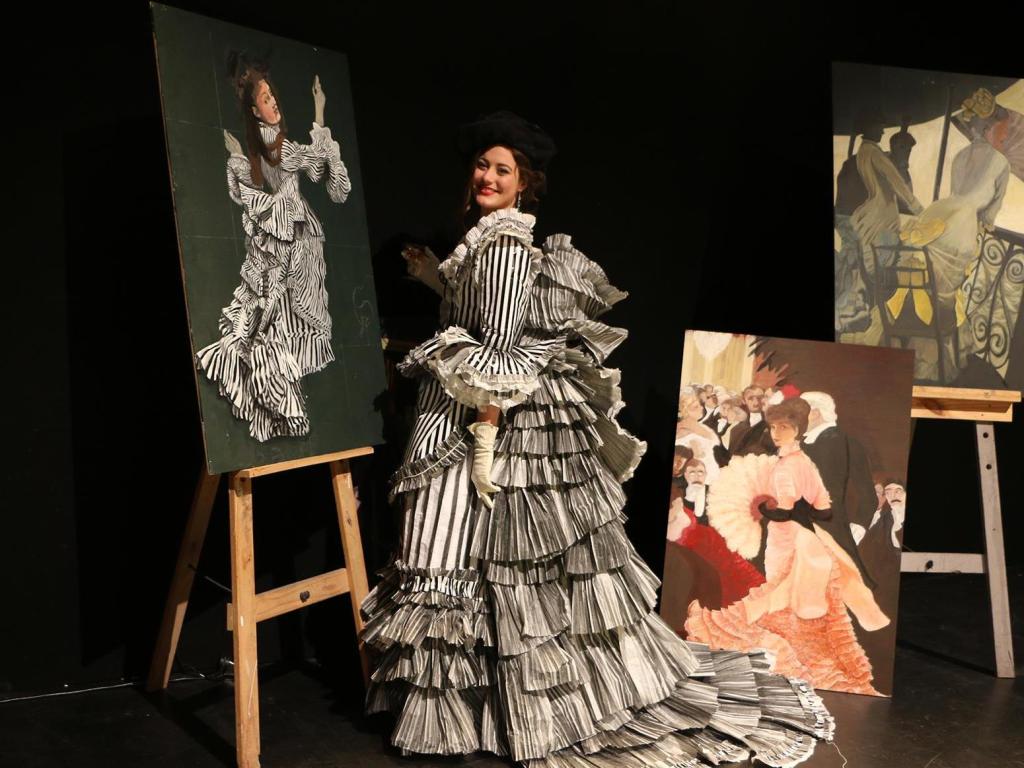Kelsey Lee’s paper costume design, inspired by James Tissot. Image supplied.
Unexpected pathways are always emerging in the creative industries, where inspiring career opportunities often present themselves.
For third year student NIDA student Kelsey Lee, who is studying a Bachelor of Fine Arts (Design for Performance), an earlier career start in technical lighting for theatres led her to pursue a career in set and costume design.
At the end of 2017, Lee was pushed to explore a new form in paper costuming, where she created a wearable design based on James Tissot’s paintings. ‘The dresses were made completely out of paper, so it was a challenge finding the best ways to make paper look like real material! Also the beautiful dresses from the paintings are period, so it was exciting creating something in a style I have never worn before,’ she said.
‘We then had to replicate those paintings as part of our scenic art subject which gave us another layer of understanding to the dresses we were creating as well as learning some pretty amazing painting skills.’
From paper costuming and designing scenic sets to screen, Lee also dived into an opportunity to work with other NIDA students designing a short film.
‘Designing for film is very different to designing for theatre and was the first time we put our film skills into action. This project is good preparation for our upcoming Triple J Unearthed music video collaboration,’ she said.
Lee said having a background in technical theatre meant it was easier for her to understand the fundamentals of staging and lighting. ‘I could figure out how to make something I had in my mind work and how to explode and challenge that,’ she said. Studying at NIDA has expanded and broaden this experience.
‘When working on my theoretical class projects, I found that I had to put a pin in some of the restraints working as a technician taught me so I could explore my imagination — retrain my brain to realise I had no boundaries. It was hard at first but I think I’ve got better.
‘It’s funny because now I’m having to reintroduce those restraints the more I’m doing realised projects, or at least negotiating a way to merge the two. The course has taught me many skills for design that I hadn’t acquired from technical theatre like model making, but also enhanced my understanding of elements like colour and scale, as well as documentation and drawing.’

Ex Machina photo by Patrick Boland. Image supplied.
For Christopher Baldwin, completing NIDA’s MFA (Design for Performance) has also led to important new skills for his career in designing for performance, providing the necessary skills in digital 3D drafting and design communication.
Baldwin started out as a fashion designer bu, after working in the fashion industry for a number of years, decided to pursue a career in set and costume design. His knowledge of textiles and costume recently led him to successfully design a 3D life size puppet for Alex Garland’s Ex Machina, directed by international puppeteer Finn Caldwell.
‘NIDA has given me a whole range of other skills in design communication, in being able to put together very clear and concise design packages — be they documentation for a set or the drafting and rendering of set models we do. And then also documenting costume designs and prop designs and really coming up with a clear way of going from concept into a completed design package and then into a fully realised design.’
Applications for 2019 NIDA courses are open on Monday 2 July until September 30, 2018. Find out more about NIDA courses including BFA (Design for Performance) and MFA (Design for Performance).





